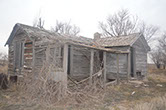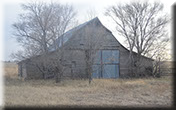

PHILLIPS COUNTY
Colorado
The Gold Rush
With the discovery of Gold in 1859 thousand of men flooded the area in and around Denver. A new road to the gold field and beyond was opened and hostilities with the Cheyenne and Sioux soon developed. The 1860’ brought war to both the east and to the plains and while the Civil War pitted brother against brother in the east, on the plains, the Indians clashed with homesteaders and the territorial military.
The year of 1864 brought a general uprising to the area along the South Platte. Indian raids were frequent. They roamed at will, burning and ransacking every white settlement they came to. Neither Indian nor white women were spared from the ravages of war.
In an effort to control the Indians, General Mitchell in 1865 ordered all stations from Ft Kearney to Denver to set prairie fires between one post and the next. He wanted the area between the Platte and the Arkansas to be void of game believing that this would force the Indians to move north of the Platte and away from the overland trail. These fires reportedly burned in to Texas and Oklahoma.
While en route to Riverside Station and Fort Sedgwick in 1867, General Custer traveled through Phillips County passing a few miles south of present day Fleming in Logan County.
In 1869, Summit Springs, the site of the last major Indian battle on the high plains happen just 20 miles west of the southeast corner of Phillips County.
Between 1870 an 1890 the Indians lost their right to live freely upon the plains, their food source, the Buffalo were wantonly destroyed and both were replaced by large herds of the white man’s longhorns and his Iron Horse that kept moving west.
General Sheridan, who was obsessed with driving the Indians from the plains, was the commander of the western department. He frequently arranged buffalo hunts which were for the “entertainment of” visiting heads of state such as Prince Alex of Russia. On one such hunt which covered an area from Fort McPherson to Fort Hayes, Sheridan recounts how he and his hunting party killed turkeys 70 miles south of of what is now Phillips County.
Entertaining visiting dignitaries was not the only reason for the hunts. By sponsoring them Sheridan, could in good conscience justify the killing of hundreds of buffalo which helped to force the Indians on to reservations. As a testament to his desires, by 1889 less than 90 head of wild buffalo were left in the United States.
By 1887 the Colorado and Wyoming Railroad, later becoming the Burlington and Missouri was incorporated. It constructed a railroad from the Colorado/Nebraska border, west towards Sterling, then running in a northwesterly direction to the northern boundary of the state.
Branch lines were to be constructed that would have meant with the Nebraska and Colorado railroad at the west boundary of Keith County
The Decade of Hardship
The 1890’s proved to be the decade of hardships for Phillips County With a population of 2,642, many of its families, having become discouraged, loaded their wagon and drifted away.
The “White Cap” trail plunged the new county in to a huge indebtedness forcing it to issue its first bond. and that winter, it rained so much that many of the Sod houses leaked making them inhabitable.
The aid society distributed food, clothing and coal to those in need and by spring there was no seed available for planting. Prairie fires were a constant threat.
In 1891 there was a prairie fire northwest of Amherst. It traveled a mile a minute and burned a strip 5 miles wide and 20 miles long. Another one in March of 1893 threatened the town of Holyoke but it was overcome when the winds died down. By August, farmers had plowed furrows around the town, giving Holyoke, its first fire protection.
1894 was the year of the big drought. Farmers had nothing and sought work in the irrigated area around Greeley, in the mines around Denver or on a railroad building crew.
1895 was not much better. Coal and flour was given to the needy if they could supply 2 witnesses to testify to their needs, or wait 5 days. In March a blizzard hit the area that lasted 3 days and nights.
1896 looked better. Many town building were moved to farms and wells were sunk for windmill irrigation. Land value went up and most people were able to pay their taxes, but it had been the railroad tax that had kept things going in the county during the lean years.
Sheep became a big industry along the Burlington and Missouri and the Parker's formed the Standard Sheep Company north of Holyoke.
But just when it seemed as though the worst was behind them another new tragedy took flight in 1897…….. Grasshoppers...literally clouds of them and as one old-timer put it “For two days there were so many in the air that we couldn't see the sun”. “Not a blade of vegetation was left standing”
It was estimated in 1896 that 75% of the original homesteaders had left their farms without proving up. Many because of the severe life, others because they couldn't raise the $16.00 cost. But the county held fast. Crop yield was moderate to poor and corn sold for 18 cents a bushel.
With the coming of a new century Phillips County continued to grow, Stock raising continued and herds got bigger, settlers came back, towns were formed, well drillers were kept busy, but prairie fires continued to be an ever present danger
The county is 32 miles wide east to west and has a population of approximately 4,480 (2000 census). The county is agriculturally based and has several thriving communities. The county offices are located in the town of Holyoke
Some More History
Click here to read the 1908 Phillips County Story as featured in Star Herald

All materials contained on these pages are furnished for the free use of those engaged in researching their family origins. Any commercial use, without the consent of the host/author of these pages is prohibited. All images used on these pages were obtained from sources permitting free distribution, or generated by the author, and are subject to the same restrictions/permissions. All persons contributing material for posting on these pages does so in recognition of their free, non-commercial distribution, and further, is responsible to assure that no copyright is violated by their submission.
Last updated December 2018
